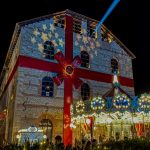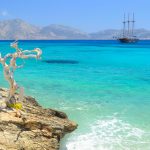Dart war in Kalamata or rocket war in Chios? Hot air balloons in Leonidio or dynamite throwing in Kalymnos? We travel around Greece, discovering the most distinctive Easter customs for the celebration of the Resurrection of Christ.
Chios: Rocket War in Vrontados
In the myrrh-bearing island of northeastern Aegean, Easter is celebrated “pugnaciously”! Although the mastic villages, the 38 Byzantine churches of Campos and the medieval monuments are a staple of attractions for visitors, during the Easter time none of these can quite compare to the Rocket War in Vrontados. The most notorious Greek Easter costume is revived every year in Vrontados since the Ottoman Occupation, sending sky-high surges of adrenaline to both participants and spectators! Young rocket builders prepare the explosive mixture of coal, niter and sulfur for their makeshift fire sticks at least one month prior to the night of Easter Mass. The whole town turns into a battlefield, as the rival parishes of Agios Markos and Panagia Ereithiani churches, which are located on opposite hilltops, get prepared. On the night of Easter Mass, hearing “Christòs Anèsti” (“Christ is Risen”) gives the cue for this unusual “war” with 10,000 rockets as “weapons”, painting the sky of Chios bright red and creating a spectacular atmosphere. The congregants-rocket builders of Agios Markos aim for the bell tower of Panagia Ereithiani, while those of Panagia Ereithiani for the bell tower of Agios Markos. Night turns into day, yet the “conflict” never seems to cease. On Easter Sunday, the members of each parish count the fallen rockets sticks, in order to proclaim the winner of the rocket war!
Corfu – The Smashing of Bòtides
During the Easter, Corfu with its Venetian traditions and the internationally famous brass bands is packed with visitors who wish to experience the unique customs of the island. The most famous and special Corfiot custom is the smashing of bòtides. In Spianada (Esplanade), the largest square in the Balkans, at 12.00 noon on Holy Saturday begins the smashing of huge clay pots (bòtides), a custom dating back to the years of Venetian Rule. People hurl clay pots decorated with red ribbons and filled with water from the balconies of mansions, with a resounding thud. Spectators flock in to gather the shards, as Corfiots insist they act as good luck charms. Then the brass bands begin to march triumphantly, with “Mi Fovàste, Graikoi”, which means “Greeks, Fear Not”!
Kalamata – Dart-war and bouloukia
The capital of Messinia, on the southwestern tip of Peloponnese, knows how to celebrate Easter the traditional way! On Easter Sunday, at the site of the former slaughterhouses, on the west side of the seemingly infinite pebbly beach of Kalamata (5 km), a different kind of ritual takes place: dart war — saitopòlemos. As this centuries-old custom of Kalamata dictates, the participants —saitològoi or saitomàchoi— form separate teams —bouloùkia—, wear traditional costumes and launch saìtes, cardboard tubes filled with gunpowder. According to legend, the origins of this folk custom of Kalamata can be traced back to the years of Greek Revolution, and it commemorates the stop the Turkish cavalry by the Messinians, who used saìtes filled with gunpowder as weapons.
Leonidion – Celebrating Easter with Colorful Hot Air Balloons
Built upon the Myrtoan Sea shores, under the watchful eye of Mount Parnon, Leonidion maintains a perfect balance between mountain and sea. Tsakonia region’s capital is one of the oldest maritime towns of Greece and a traditional settlement with old mansions, towers and historical listed monuments. But what makes it so famous —apart from its delicious eggplants and the preservation of Tsakonian language—is the Night of Hot Air Balloons, one of the most spectacular Greek Easter customs. Every family in Leonidio make their own hot air balloon —which can be up to 2 m (6.5 ft) tall— with glue, reed and colored paper weeks before the night of Easter Mass, and they use kolimàra, a cloth soaked in oil and petrol, to light it up. According to the locals, each parish prepares at least 100 hot air balloons. The night of Easter Mass has begun: religious ambiance is abound, Easter candles are lit and colorful “lanterns” are ready to set the night on fire… All locals and visitors, without exception, eagerly await for the priests to announce that “Christ is Risen”, so they can enjoy the majestic spectacle. As soon as the speakers announce the Resurrection of Christ and the bells begin to chime triumphantly, kolimàrai are ignited, the 500-600 handmade hot air balloons from all five parishes of Leonidion begin to float slowly in the Arkadian sky and set fire to the darkness before they skink into the sea after 30 or 40 minutes. Thousands of fireworks, firecrackers and petards accompany the flight of the hot air balloons, adding to an already magnificent extravaganza. Weather permitting, the flames of Leonidio hot air balloons can be seen all the way to Spetses and Nafplion.
Tinos – Medieval Tribónia Ward Off Evil
In Tinos, the island of dovecotes, marble sculptures and Gianoulis Halepas, Easter is celebrated with great religious reverence and deep solemnity. On Holy Saturday night and Easter Sunday noon, the medieval custom of tribónia αναβιώνει in many villages of the mainland, like Pyrgos, Steni, Tarambados and Kardiani, revives.
Tribónia, old bulletless rifles that are passed on from one generation to another, can be filled with gunpowder from the barrel, are ignited with a primer cartridge and produce a terrible, deafening sound that can be heard all over the island. Locals believe that triboniès, as they call these ear blasting sounds, can ward off evil spirits.
Kalymnos – Explosive Easter with Dynamites
Easter on the island of sponge divers is literally… explosive, and its one of the kind celebration offers a very good reason to visit the fourth largest island the Dodecanese, Kalymnos. On Holy Saturday noon the bells announcing the First Resurrection of Christ give the cue to the dynamite throwers for the first ear blasting explosions at the dock of the port. People lined up around the dock watch transfixed the sky ablaze in light and the rain of dynamites! On Easter Sunday, after Kalymniots have savored the traditional muùri (stuffed lamb in a casserole dish, roasted in wood stove), noisy celebrations continue as two teams of youngsters from maràsia (sponge divers’ neighborhoods) climb on the clifftops of Agios Nikolaos and Agios Stefanos above Pothia, the capital of the island, to make Kalymnos’ ground shake from side to side! The throwers on the mountains as well as their “rivals” on the waterfront and Pothia square keep on hurling dynamites, and the sight is visible from the island of Kos and the Turkish coastline.
Meteora – Easter on the Aeries of Orthodox Christianity
Perched on steep clifftops, the Byzantine monasteries of Meteora seem suspended midair, leaving first-time visitors in awe. Only 6 of the 30 established monasteries are still functional. This stone forest towering over Kastraki and Kalabaka is the ideal place for someone who wishes to experience unprecedented feelings of immediate contact with the Divine, away from fanfares. In Meteora, Epitàphioi are adorned in the most discreet way, without the usual bier, while liturgies of the Holy Week are appropriately characterized by spiritual elevation and mysticism.
Hydra – The Procession of the Bier of Christ into the Sea
Cosmopolitan yet traditional, the It Girl of Saronic Gulf, Hydra, promises a most memorable Easter experience to its visitors, as during the Holy Week old inextricably linked with the sea customs revive. On the night of Good Friday, Epitàphioi of all parishes of the island converge to Kountourioti Square before the port. Yet, earlier, on Kaminia district has run ahead the procession of Bier of Christ of Agios Ioannis Prodromos church literally in the sea. It is said that this custom was initiated back in 1923 by local sponge divers, who decided to parade the Bier of Christ in the sea for the blessing of waters and the protection of sailors. On Holy Saturday, the fireworks light up the sky above the port of Hydra, while on Easter Sunday the burning of the effigy of Judas takes place in front of the Merchant Marine Academy at the port of Hydra. The participants build up the bonfires to burn the effigy, which is stuffed with flammable material, on the dock, creating a particularly impressive spectacle.
Keep in mind that the procession of the Bier of Christ into the sea takes place one hour prior to the rest, so that visitors of Hydra can attend all the rituals.
Nafpaktos – Good Friday the «flaming» Venetian port
Only a 2 hour-drive from Athens, Nafpaktos is a favorite beachfront destination for weekends — and not only. The quaint Venetian port overlooking the Corinthian Gulf and reminiscent of the Battle of Lepanto (the Venetian name of Nafpaktos) in 1571, the well preserved medieval Venetian fortress, and Palià Pòli (Old City) fascinate every visitor in the blink of an eye. Add the villages of Orini Nafpaktia (Greek for the mountainous area of Nafpaktia) and the dense forests of the area, and you have more than one good reason to visit the second largest town of Aetolia-Acarnania. Yet, another great occasion for a trip to Nafpaktos is Good Friday, the culmination of the Passion of Christ with the Deposition of Christ and the procession of Epitàphioi (Bier of Christ) on the streets of the town. The Epitàphioi of Agia Paraskevi and Agios Dimitrios parishes, accompanied by the municipal brass band and hundreds of pious faithful, forming corteges up to the medieval fortress, end up to the crowded Venetian port. Nafpaktos is steeped in darkness while lit torches on the Venetian walls and crenellations illuminate the picturesque port. The burning cross in the middle of the port entrance, the priests chanting the gospels of Good Friday, and the dozens of fireworks setting fire to the night sky set up a mesmerizing scenery.
Patmos – Easter on the Isle of the Apocalypse
As a land of deeply religious background, Patmos is a favorite destination in the Dodecanese complex for the holy days of Easter. The “Jerusalem of the Aegean” is home to the Cave of the Apocalypse, where according to tradition John the Evangelist wrote the Book of Revelation, the final sacred book of the New Testament, preaching prophesying the victory of life over the powers of Evil. Perched on the top of the main town, Chora, we find another landmark of Patmos, the Monastery of Agios Ioannis Theologos. This medieval fortress monastery with an impressive courtyard and imposing watchtowers has a great history, and its interior is home to some 13,000 rare documents, icons and Byzantine artifacts. In the Isle of the Apocalypse, Holy Week is a truly unique experience as all celebrations, customs and rituals are held in a monasterial and deeply somber manner. On Maundy Thursday, a reenactment of The Washing of the Feet ritual takes place in front of the Town Hall, in Xanthos square in Chora. The Hegumen (Abbot) of the Monastery of Agios Ioannis Theologos, performing the role of Christ, sprinkles with water the feet of twelve clergymen seated on the raised platform like the disciples on the Last Supper. The solemn chants, elaborate vestments, and wafting scent of lavender flowers create an emotionally charged atmosphere. On Easter Sunday, Patmos celebrates the Resurrection of Christ in the square of Skala (the port of Patmos) with traditional dances and a great Easter feast with red eggs, hand-made cheese pies, Easter bread and other local delicacies! In the Monastery of Theologos, during the Love Vespers, the Gospel of John is read in seven languages as well as in the Homeric dialect, and the Hegumen gives out red eggs to the congregation.







